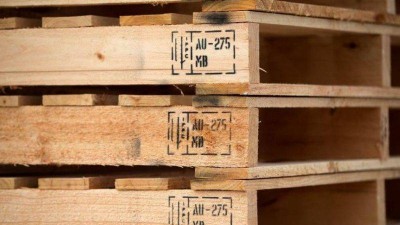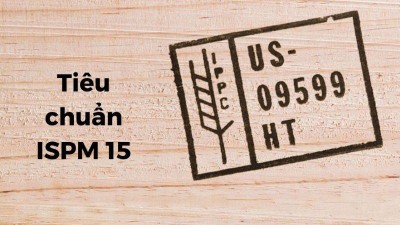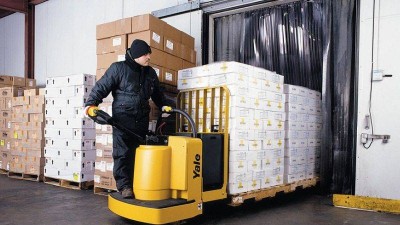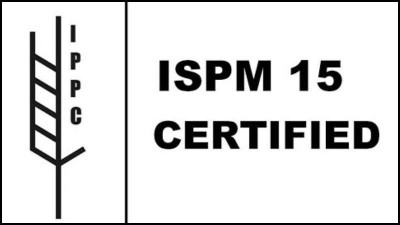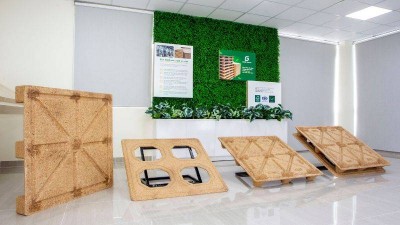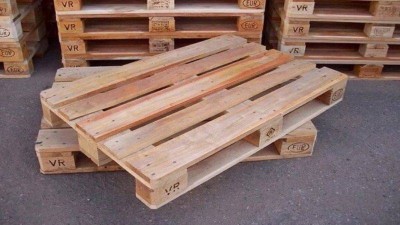ISPM 15 Standard Pallets: Standards, Handling & Notes
IPPM15-compliant pallets are a mandatory solution when businesses want to export goods to international markets, ensuring biosafety and avoiding quarantine risks. At Green Pallet, we provide molded wood pallets that are fully treated and certified according to ISPM15 standards, giving customers peace of mind in every shipment. If you are interested in learning about this standard, let's explore the details below!
What is an ISPM15-compliant pallet?
ISPM15 (International Standards for Phytosanitary Measures No. 15) is a set of international standards on phytosanitary measures, issued by the Food and Agriculture Organization of the United Nations (FAO) and the International Plant Protection Commission (IPPC). This regulation aims to control the use of wood materials in packaging, pallets, crates and packing to prevent pests and molds from spreading across borders.
According to ISPM15, all wooden pallets used for export must undergo an approved fumigation treatment (such as heat treatment or Methyl Bromide gas fumigation). After treatment, the pallet must be stamped with a valid IPPC certification, clearly showing the country code, treatment facility code and treatment method. This is a global legal basis to ensure that goods are transported safely and in compliance with the quarantine requirements of importing countries.
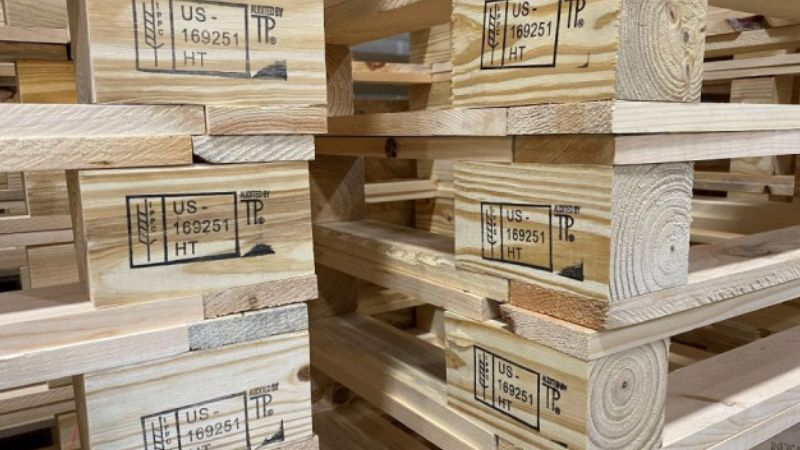
Purpose and importance in international trade
The goal of ISPM15 is to protect the ecosystems and agriculture of countries from the risk of spreading pests from untreated wood materials. Applying ISPM15 helps:
- Ensure biosecurity: eliminate the risk of insects and pathogens entering.
- Reduce the risk of being returned or fined: goods that do not meet ISPM15 standards are often refused import.
- Increase business reputation: using international standard pallets creates a competitive advantage when exporting.
- Promoting global trade: standardizing regulations makes the import and export process more convenient, transparent and faster.
Treatment methods according to ISPM15 standards
1. Heat Treatment (HT): process, temperature parameters & time
Heat Treatment (HT) is the most popular way to bring wooden pallets to ISPM15 standards. In this process, the pallet is put into a drying oven or a specialized heat chamber. The wood must reach a core temperature of at least 56°C for at least 30 minutes continuously.
Advantages of HT:
- Environmentally friendly, no chemicals used.
- Maintain the mechanical quality of the wood.
- Accepted by most countries.
2. Chemical fumigation (Methyl Bromide - MB): concentration, CT, time
Fumigation with Methyl Bromide (MB) is a method that uses chemical gas to kill pests. Pallets are placed in a sealed chamber, pumped with Methyl Bromide gas at a concentration and time according to international standards (usually 16 hours at 48g/m³ at 21°C).
However, MB has disadvantages:
- Harmful to human health if exposed directly.
- Affects the ozone layer, so it is being restricted or banned by many countries.
- Higher processing and labor safety costs compared to HT.
3. Alternative methods (eg: dielectric heat) - latest update
In addition to HT and MB, there are currently new technologies being researched to replace MB, for example:
- Dielectric Heat (DH): uses electromagnetic waves (microwaves or radio) to heat wood from the inside. This method helps heat distribute evenly and faster than HT.
- Combined technology: heat drying + dehumidification, to save energy and increase processing efficiency.
Several countries have begun to experiment with alternative methods to reduce their dependence on MB while meeting environmental protection goals.
Identifying signs of ISPM15-compliant pallets
1. Structure of the IPPC mark: symbol, country code, treatment provider code, HT/MB symbol
A wooden pallet that meets ISPM15 standards always has an IPPC certification mark printed, engraved or stamped directly on the wood surface. This mark has a globally consistent layout:
- IPPC (International Plant Protection Convention) symbol: a stylized barley ear, located in the left corner. This is an important element for quick identification.
- Country Code: an abbreviation according to the ISO 2-letter standard, for example: VN (Vietnam), US (United States), CN (China).
- Treatment Provider Code: a numeric or letter symbol issued by the national plant quarantine agency specifically for each treatment unit.
- Treatment method symbol: including HT (Heat Treatment) or MB (Methyl Bromide - gas fumigation). This is a mandatory part to prove that the pallet has undergone fumigation according to international standards.
2. Marking conditions and regulations on debarked wood
According to ISPM15 regulations, wooden pallets are only allowed to be marked when they have undergone standard treatment and meet the following conditions:
- Wood must be debarked: all bark must be removed. However, some small pieces with a size of less than 3cm wide and not more than 50cm long are still accepted.
- The mark must be durable and easy to read: usually printed or hot-engraved, red or orange must not be used (to avoid confusion with danger marks).
- Do not reuse the mark: if the pallet is repaired, recycled or replaced, it must be re-treated and a new mark must be affixed.
These regulations help ensure that pallets do not carry pathogens, insects or harmful microorganisms, thereby protecting the ecosystem in the importing country.

Products and cases exempted from ISPM15
1. Plastic pallets, corrugated pallets, plywood, sawdust... exempted from treatment
Not all wood packaging materials must comply with ISPM15. Some cases are exempted because there is no risk of carrying pathogens from natural wood, typically:
- Plastic pallets, metal pallets: completely unrelated to wood, no need for treatment.
- Paper pallets, corrugated cardboard boxes: made from recycled paper, do not contain solid wood.
- Plywood, OSB, MDF, industrial plywood: in the production process, high heat and pressure are used, enough to kill harmful organisms.
- Recycled wood products from sawdust, plywood chips: are also exempted from ISPM15 control.
2. When do recycled wooden pallets need to be reprocessed?
With natural wooden pallets that have been treated and have the ISPM15 mark, if during use:
- The pallet is damaged, the wooden bar must be replaced,
- Or the structure is repaired or reprocessed,
then the entire pallet must be reprocessed and a new ISPM15 mark must be affixed. This is a principle to ensure that all wooden parts are safe, free of termites or fungi.
In the case that the pallet is only reused in its original state (no repair, no replacement of parts), the old mark is still valid and the pallet continues to be valid in international trade.
Signs to identify pallets that meet ISPM15 standards
1. Structure of the IPPC mark: symbol, country code, processor code, HT/MB symbol
An ISPM15-compliant wooden pallet always has the IPPC certification mark printed, engraved or stamped directly on the wood surface. This mark has a uniform layout globally:
- IPPC (International Plant Protection Convention) symbol: stylized barley flower, located in the left corner. This is an important element for quick identification.
- Country Code: 2-letter ISO abbreviation, for example: VN (Vietnam), US (United States), CN (China).
- Treatment Provider Code: a numeric or letter symbol issued by the national plant quarantine agency specifically for each treatment unit.
- Treatment method symbol: includes HT (Heat Treatment) or MB (Methyl Bromide - gas fumigation). This is a mandatory part to prove that the pallet has undergone a fumigation process according to international standards.
Looking at this mark, businesses and customs can immediately determine whether the pallet is eligible for circulation in international trade.
2. Marking conditions and regulations on debarked wood
According to ISPM15, wooden pallets are only allowed to be marked when they have undergone standard treatment and meet the following conditions:
- Wood must be debarked: all bark must be removed. However, some small pieces less than 3cm wide and not more than 50cm long are still accepted.
- The mark must be durable and legible: usually printed or hot-etched, red or orange (to avoid confusion with hazard marks) must not be used.
- The mark must not be reused: if the pallet is repaired, recycled or replaced with parts, it must be re-treated and a new mark must be applied.
These regulations help ensure that the pallet does not carry pathogens, insects or harmful microorganisms, thereby protecting the ecosystem in the importing country.
Products and cases exempted from ISPM15
1. Plastic pallets, corrugated pallets, plywood, sawdust... exempted from treatment
Not all wood packaging materials must comply with ISPM15. Some cases are exempted because there is no risk of carrying pathogens from natural wood, typically:
- Plastic pallets, metal pallets: completely unrelated to wood, no need for treatment.
- Paper pallets, corrugated cardboard boxes: made from recycled paper, do not contain solid wood.
- Plywood, OSB, MDF, industrial plywood: in the production process, high heat and pressure are used, enough to kill harmful organisms.
- Recycled wood products from sawdust, plywood chips: are also exempted from ISPM15 control.
2. When do recycled wood pallets need to be reprocessed?
With natural wooden pallets that have been treated and have the ISPM15 mark, if during use:
- The pallet is damaged, the wooden bar must be replaced,
- Or there is a repair or reprocessing of the structure,
then it is mandatory to reprocess the entire pallet and stamp a new ISPM15 mark. This is a principle to ensure that all wooden parts are safe, free of termites or fungi.
In the case that the pallet is only reused in its original state (no repair, no replacement of parts), the old mark is still valid and the pallet continues to be valid in international trade.
Conclusion
ISPM15 standard pallet are not only a mandatory requirement in export activities but also a solution to ensure safety and reputation for businesses. Green Pallet is currently providing ISPM15 standard pallets with professional processing procedures, helping customers feel secure when transporting goods internationally. Choosing Green Pallet is a sustainable choice, optimizing costs and fully complying with global regulations.


